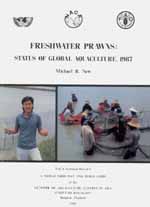
STATUS OF GLOBAL AQUACULTURE, 1987
 | FRESHWATER PRAWNS: Michael B. NewSTATUS OF GLOBAL AQUACULTURE, 1987 |
NACA Technical Manual 6
A WORLD FOOD DAY 1988 PUBLICATION
of the
NETWORK OF AQUACULTURE CENTRES IN ASIA
(UNDP/FAO RAS/86/047)
Bangkok, Thailand
1988
FRESHWATER PRAWNS: Status of Global Aquaculture, 1987.
Michael B. New
Printed in Bangkok, Thailand
Published by the
Network of Aquaculture Centres in Asia
c/o UNDP, GPO 618, Bangkok, Thailand.
New, Michael B. 1988. Freshwater Prawns: Status of global aquaculture, 1987. NACA Technical Manual No. 6. A World Food Day Publication of the Network of Aquaculture Centres in Asia. Bangkok, Thailand. 58 p.
Hyperlinks to non-FAO Internet sites do not imply any official endorsement of or responsibility for the opinions, ideas, data or products presented at these locations, or guarantee the validity of the information provided. The sole purpose of links to non-FAO sites is to indicate further information available on related topics.
This electronic document has been scanned using optical character recognition (OCR) software. FAO declines all responsibility for any discrepancies that may exist between the present document and its original printed version.
PRODUCTION TECHNOLOGY AND PRACTICES
Biology with Reference to Broodstock
HARVESTING, PROCESSING, MARKETING AND ECONOMICS
This is one of the World Food Day publications series, a contribution of the Network of Aquaculture Centres in Asia (NACA) to the global effort of the United Nations Food and Agriculture Organization to solve the problems that cause hunger and malnutrition. NACA is a regional programme aimed at promoting the expanded development of aquaculture in the Asia-Pacific Region through technical cooperation in training, research and information exchange.
Sixth in the series, this number reviews the global status of the giant freshwater prawn, one of the species that have shown remarkable potential as a cash crop for small farmers and a source of foreign exchange.
The author of this number, Mr. Michael New, formerly a senior aquaculturist with the Aquaculture Development and Coordination Programme of FAO, has spent several years in Thailand conducting research, in association with Thai aquaculture scientists, on Macrobrachium rosenbergii. He is a strong advocate of collaboration in technological endeavours among workers of different national research and development systems and a firm proponent of technical cooperation.
While previous numbers described a package of practices needed to produce a certain aquaculture commodity or manage a particular aquaculture production system, this one presents a comprehensive description of the culture of a particular species in several countries. It is consistent with the objective of NACA to put together and thus make more accessible to national planners, researchers, project managers, technicians and farmers information that is relevant and understandable.
We hope the information in this volume will find useful application in national aquaculture development activities.
CHEN Foo Yan
Coordinator
Though the farming of freshwater prawns (Macrobrachium spp.) forms only about 6 per cent of the global aquaculture production of shrimps and prawns it is of considerable local importance particularly in Thailand and Taiwan. Farmed freshwater prawns are now entering global, as well as domestic markets, a development likely to stimulate renewed interest in Macrobrachium culture in other tropical countries. This review summarizes the status of freshwater prawn culture globally in 1987 in terms of rearing technology, marketing and economics.